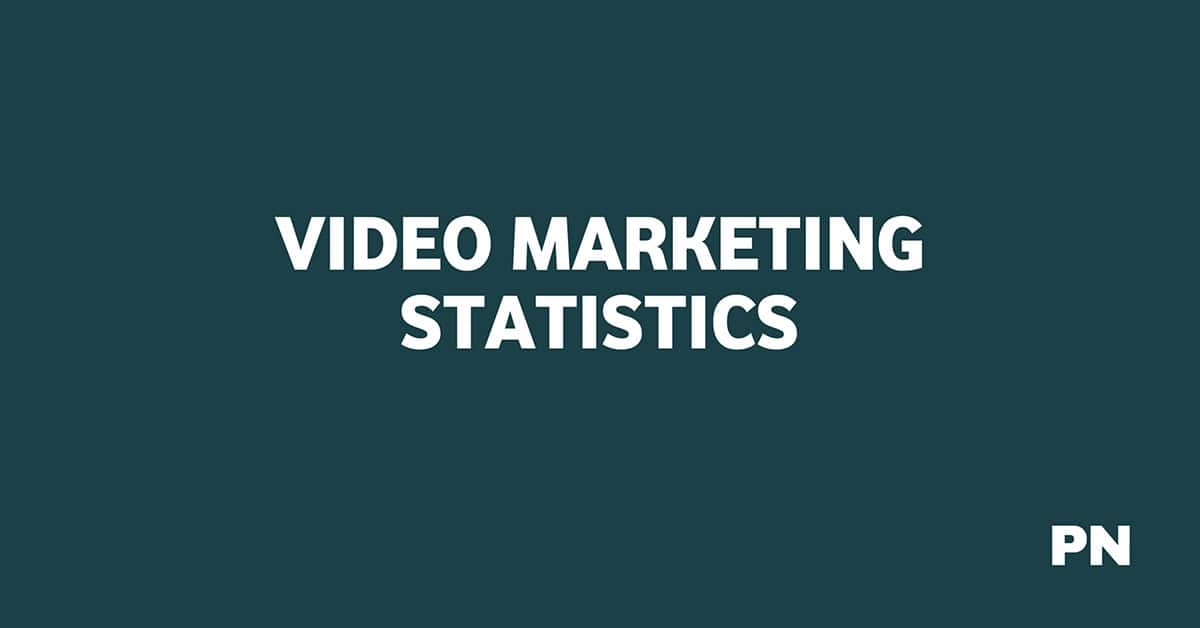55 Video Marketing Statistics & Market Size

In the dynamic world of digital marketing, video has emerged as a powerful tool for businesses aiming to connect with their audience.
With the digital video advertising market projected to grow to $553.6 billion by 2032, video content has become a strategic imperative for any brand’s growth.
This growth is powered by user engagement; statistics show that over 1 billion hours of YouTube content are watched daily, with video becoming the preferred medium over traditional blog posts and infographics.
Leveraging video content enhances brand visibility and significantly increases lead generation and sales potential. A robust 91% of businesses employ video marketing, and 92% of marketers recognize its importance in their strategy.
In this article, I discuss my favorite video marketing statistics and explore how video content can increase brand visibility and lead generation.
1. The Global Digital Video Advertising Market Size is to Grow from USD 53.6 Billion in 2022 to USD 553.6 Billion by 2032 at a Compound Annual Growth Rate (CAGR) of 26.3% during a projected period.
(Source: Globe News Wire)
Understanding the video advertising market’s trajectory is essential in the digital landscape. The market is on a rapid incline, with its valuation expected to increase substantially over a decade.
This persistent expansion is fueled by technological advancements and evolving consumer preferences, necessitating a pivot towards more visually engaging and immersive ad formats.
2. Over 1 billion hours of video content are watched daily on YouTube.
(Source: YouTube)
Engagement with video content on YouTube is substantial. This engagement isn’t just from personal computers but extends significantly to smart TVs, where users add more than 450 million hours of viewing daily.
Interestingly, these hours translate into a staggering consumption rate. YouTube’s viewership doesn’t just mirror traditional media but likely surpasses it when considering the diversity of content and the personalization of viewer experiences.
Considering these statistics, integrating YouTube into your video marketing strategy could offer substantial exposure and potential customer engagement.
Your content could contribute to the extensive hours of daily viewership, connecting with viewers across various devices and platforms.
3. More than 244 million online video viewers are in the United States.
(Source: WebFx)
This impressive figure highlights the scope and reach of video marketing opportunities in that market. You are not just casting a wide net; you’re engaging with a vast and diverse audience already actively consuming video content.
This audience spans various platforms, from dedicated streaming services to social media channels, providing multiple touchpoints for your marketing strategy.
Remember, as a marketer, your potential reach equates to more than two-thirds of the US population. This ingrained habit of video consumption can work significantly in your favor.
By tailoring content to different demographics within this broad audience, you can create targeted campaigns that resonate personally, leading to higher engagement rates.
4. 91% of businesses use video as a marketing tool.
(Source: WyzOwl)
This figure significantly increases from previous years, illustrating a growing recognition of video’s potent ability to engage audiences. You may miss significant engagement and conversion opportunities if you’re not yet using video as a daily tool.
It’s a clear favorite in the marketing community for its versatility and effectiveness in conveying messages, and it has secured its place as a mainstay in marketing arsenals across the globe.
5. 92% of marketers say video is an important part of their marketing strategy.
(Source: HubSpot)
Understanding the importance of video in your strategy is crucial as a marketer. This figure highlights a clear consensus within the industry regarding the value of video content.
Leveraging video content in your marketing strategy allows you to stay competitive and meet your audience where they are most active.
Embrace the trend that a commanding majority of marketers are capitalizing on, and incorporate video into your marketing toolbox to enrich your brand’s narrative and connect with your audience on a deeper level.
6. Video is the #1 form of media used in content marketing, overtaking blogs and infographics.
(Source: HubSpot)
This shift points to your audience’s growing appetite for dynamic and engaging content that videos can uniquely provide. Incorporating video into your content strategy taps into a powerful trend that resonates with consumers and marketers alike.
It’s not just preferred over blogs and infographics; it also plays a critical role in effectively engaging your audience and facilitating a more compelling brand conversation.
7. 88% of people say they’ve been convinced to buy a product or service by watching a brand’s video.
(Source: Wyzowl)
This statistic is not just a number; it indicates the decisive role that video marketing plays in consumer decisions.
Your decision to integrate video into your marketing strategy does not solely rely on these numbers, but it highlights that incorporating video could significantly enhance your engagement with potential customers.
The personalized effect of a well-crafted video might be that final push a consumer needs to move from consideration to purchase.
8. Over 75% of all online videos are viewed on mobile devices.
(Source: WebFx)
Digital media consumption has shifted significantly toward mobile devices. A substantial portion of online video views now occurs on smartphones and tablets.
In light of this, your video marketing strategies should prioritize mobile compatibility to meet viewers where they are. As you craft your videos, consider loading times, mobile data usage, and platform-specific constraints to ensure a seamless viewing experience on mobile devices.
9. Video marketers get 66% more qualified leads per year.
(Source: OptinMonster)
As a marketer, you should be aware that incorporating video into your strategy is more than a visual preference—it’s a powerful tool for increasing your leads.
Remember, these leads are not just raw numbers—they are potential customers who have shown a legitimate interest in what you offer.
Videos have proven to be a robust tool for nurturing leads. They can attract, inform, and engage viewers more effectively than other content types. As you plan your marketing strategy, consider integrating video content to capitalize on its lead-generation potential.
10. The average person spends 6 hours and 48 minutes per week watching online videos.
(Source: Exploding Topics)
This sheds light on the significant role that online video plays in daily entertainment and information seeking. Online video content has become a mainstay in media consumption, rivaling traditional television in popularity.
This shift points to a greater demand for diverse video content, ranging from short clips on social platforms to longer-form content on dedicated streaming services.
The hours you spend watching videos online represent more than superficial pastime data – they hint at evolving preferences for visual over written content, increased mobile usage, and a move towards on-demand entertainment.
Whether for learning, entertainment, or connecting your screen time is part of this digital transformation.
11. By 2025, it’s predicted that video will make up more than 82% of all consumer internet traffic.
(Source: Cisco)
The trajectory of consumer internet traffic is leaning heavily towards video, signaling a transformative shift in how you consume online content.
This trend highlights the burgeoning dominance of video content. As a marketer or business owner, your digital strategy should heavily prioritize video content, catering to a growing audience that prefers dynamic and engaging modes of information over static text.
12. 75% of Millennials watch videos daily on social media.
(Source: Gitnux)
If you’re a millennial who watches videos on social media daily, you’re part of a significant trend. Recent statistics highlight the integration of video content into the daily routines of this demographic.
Your engagement with video content shapes the future of how brands interact with you, proving your influence in digital marketing.
13. 161.4 million people watched live video content in 2023—this is projected to increase to 164.6 million in 2024.
(Source: Statista)
In 2023, 161.4 million people engaged with live video content, marking a significant foothold for live streaming in digital marketing. As you plan your strategies, you should note that this number is not static—it reflects a growing trend that is anticipated to rise in 2024.
The allure of live video content is undeniable; it offers real-time engagement and generates a sense of immediacy and authenticity that pre-recorded content cannot match.
Considering the emerging technologies and platforms, live streaming is diversifying. With 50% of TikTok users reportedly making purchases after watching a live stream, the impact on e-commerce is substantial.
Additionally, over half of the companies utilized live video, recognizing its potential to drive results.
Your marketing arsenal must adapt to incorporate live video strategies to remain effective in 2024 and beyond. Its projected growth signifies a demand from consumers for authentic, in-the-moment content that live video perfectly encapsulates.
14. Video ads have an average click-through rate of 1.84%, the highest of all digital ad formats.
(Source: Business Insider)
Regarding digital advertising, video ads stand out because they effectively capture the audience’s attention. The key metric to understand this impact is the click-through rate (CTR), which measures the percentage of viewers who click on an ad after seeing it.
This efficiency speaks to the growing preference for video content, a trend that looks set to continue shaping the online advertising landscape.
15. Mobile video consumption rises by 100% every year.
(Source: State of Digital Publishing)
Year after year, mobile user experience becomes increasingly video-centric. An astonishing trend reveals that mobile video consumption is doubling annually.
This phenomenon suggests an undeniable shift in content preferences—a move towards more dynamic and engaging formats. With the consumer’s growing propensity for mobile video, your brand’s message can reach a broader audience through this preferred medium.
Noteworthy is the rise of social media as a critical video content distributor, indicating that your marketing efforts should consider platforms where your target audience spends significant time consuming video.
16. 70% of YouTube viewers watch videos for help with a problem they’re having in their hobby, studies, or job.
(Source: Think with Google)
YouTube has established itself as a critical resource for individuals seeking solutions and assistance across various aspects of their lives. This trend highlights YouTube’s instructional value, positioning it as more than just an entertainment hub.
17. 83% of video marketers say video helps them with lead generation.
(Source: HubSpot)
In the evolving digital marketing landscape, video content has proven to be a powerhouse for lead generation.
Incorporating video into your marketing strategy isn’t just about staying on trend; it’s about engaging with your audience on a platform they increasingly favor. Your approach to video content could be the pivotal step in advancing your lead generation efforts.
18. 59% of executives say they would rather watch a video than read text.
(Source: Forbes)
This preference signifies trends in content consumption that could impact how you deliver your business message.
While text can be informative, videos are perceived to offer a more engaging and efficient experience for busy executives. Your audience likely includes decision-makers who value their time and prefer video for its immediacy and ease of consumption.
19. People spend 2.6x more time on pages with video than without.
(Source: Brightcove)
This data suggests that incorporating videos into your web pages could transform the user experience, potentially leading to deeper engagement with your content.
Users prefer a dynamic visual element when browsing online, resulting in more substantial on-page time when video is present.
Incorporating video across various sections of your website, such as blog posts, landing pages, and product descriptions, could be a strategic step in fostering engagement and adding value to the visitor experience.
20. By 2030, about 35% of UGC will be created using AI tools.
(Source: Dash)
Remember, the rise of AI in UGC doesn’t just impact content creators.
As a consumer, you’ll likely notice a surge in personalized and interactive experiences that resonate with your preferences. Keep an eye on how AI shapes the future of the content you love to share and consume.
21. 56% of people say that YouTube is their preferred video platform.
(Source: Dash)
YouTube garners a significant share of viewers’ preferences when consuming video content. This is a testament to the platform’s robust ecosystem that caters to diverse interests and needs.
If you’re creating video content, you can’t ignore YouTube’s reach. Tailoring your strategy to develop content for YouTube could put your work in front of a majority of the audience that prefers this platform.
22. 88% of marketers are satisfied with the ROI of their video marketing efforts on social media.
(Source: Wyzowl)
The high level of satisfaction with video marketing ROI reflects the effectiveness of video content in reaching and engaging with audiences on various social media platforms.
When you incorporate video into your marketing strategy, you leverage a dynamic tool that can significantly enhance your brand presence and drive user engagement.
Remember, your content must be tailored to your target audience to maximize ROI. Social media platforms offer robust analytics tools to help you understand viewer preferences and behavior.
Use these insights to refine your video marketing strategy, ensuring your content resonates with audiences and aligns with your marketing objectives.
23. 90% of video marketers say video has helped them increase brand awareness.
(Source: Wyzowl)
As a marketer, you should be acutely aware of the influential power of video content. This is not a statistic to take lightly; it underscores visual storytelling’s impact on cultivating a brand’s image and presence.
Integrating video into your marketing strategy increases the likelihood that potential customers will recognize and remember your brand.
Consistent and engaging video content can enhance visibility and foster a recognizable brand identity.
24. Video content on social media generates 1200% more shares than text and image content combined.
(Source: Forbes)
This statistic highlights the significant impact that video content can have on your social media strategy.
Videos are inherently more engaging. They can convey emotion and information more effectively than static images or text alone.
Your audience will likely remember 95% of the content they watch in a video, a stark contrast to the 10% when reading text. Videos are easy to share, and viewers are likelier to pass on dynamic and engaging content.
25. 92% of mobile video viewers share videos with others.
(Source: RendrFx)
As a mobile video viewer, you are part of a digital behavior shaping how content goes viral. This sharing habit underscores the power of video marketing and its potential to expand reach organically.
Sharing a video is not just about passing content along; it’s about participating in a cycle that benefits content creators and marketers by organically boosting their messages.
Your action feeds into a larger ecosystem of content circulation, making sharing an integral part of video marketing’s success.
26. 43% of people want to see more video content from marketers in the future.
Your audience is signaling a clear preference for video content. This burgeoning interest shows the need for businesses to integrate video marketing strategies into their overall promotional efforts.
Remember, with nearly half of consumers looking forward to more video content, neglecting this medium is not an option.
Embrace the potential of video marketing to meet your audience’s expectations and expand your brand’s reach.
27. Product videos can increase purchases by 144%.
(Source: StacksandStacks.com)
In eCommerce, the impact of product videos on purchase behavior is profound. When you incorporate product videos into your online store, you stand to boost sales significantly.
The effectiveness of product videos lies in their capacity to showcase products dynamically and comprehensively. A well-crafted product video can highlight features, demonstrate use, and convey a product’s value, thus reducing uncertainty and building consumer confidence.
Leveraging product videos will likely lift your eCommerce conversion rates. Remember, not just the presence of videos matters, but their quality and relevance to your audience.
28. 94% of video marketers plan to continue using YouTube as a channel in their marketing strategy.
(Source: Biteable)
YouTube’s unparalleled reach and diverse content make it an essential platform for your video marketing strategy. With a sizable amount of video marketers affirming their commitment to YouTube, it’s clear that this platform remains a staple in the digital marketing arena.
Remember, as a video marketer, continuous use of YouTube is not just about the presence of your content but also about engaging with your audience, analyzing performance metrics, and adapting to evolving viewer preferences.
Keep abreast of changing YouTube algorithms and viewer behavior to ensure your video content effectively reaches its intended demographic.
29. 51% of marketers say video helps them improve SEO.
Your use of videos can significantly influence how your content ranks in search engine results. Search engines prioritize content that engages viewers, and videos often lead to more extended page visits, signaling the value of your content to search algorithms.
30. 73% of marketers are using live video in their marketing strategies.
(Source: DemandSage)
Live video has become an essential tool in your digital marketing arsenal. Live streaming is a versatile platform for various content, from Q&A sessions to live demonstrations of products.
Remember, consistency in delivering live content can help build a loyal viewership. By utilizing live video effectively, you can create an interactive and engaging experience that supplements your overall marketing strategy.
31. 83% of consumers would consider sharing a brand video they enjoy with friends.
(Source: HubSpot)
This shows the power of video content in fostering digital word-of-mouth marketing.
By effectively leveraging video content, you position your brand to tap into networks beyond your immediate reach. Encouraging shares isn’t just about broadening awareness—it’s about building relationships and trust between your brand and your audience.
32. Video Content on Landing Pages Can Increase Conversions by 86%.
(Source: Eye View Digital)
Incorporating video into your landing pages is a powerful strategy to enhance conversion rates significantly. This data suggests that video content deeply resonates with users, holding the potential to substantially amplify your marketing results.
Leverage this strategic advantage and consider integrating video into your landing page design to increase conversions substantially.
33. Using the word “video” in an email subject line increases open rates by 19%.
(Source: SendPulse)
When crafting your email marketing campaign, including specific keywords in your subject line can significantly influence your open rates. For example, incorporating the word “video” into your subject line can potentially increase your open rates.
This increase is attributed to the compelling nature of video content, which is known to engage users and pique their interest.
Your target audience’s inbox is likely filled with competing messages. Your ability to stand out with an enticing subject line is crucial. Utilize the word “video” wisely to tap into enhanced open rates and drive greater engagement with your email campaigns.
34. Video is the most memorable form of content, with viewers recalling 95% of a message after watching it.
(Source: Insivia)
When you watch a video, your ability to remember the content significantly outperforms other forms of communication.
Whether you’re a marketer crafting your strategy or a digital media consumer, video is compelling. It is the most memorable form of content available, making it a critical component of effective communication strategies.
35. User-generated videos on YouTube receive 10x more views than brand-produced videos.
(Source: ReelSEO)
When you browse through YouTube, it’s evident that user-generated content (UGC) has a massive appeal. This shows a shift in what viewers find engaging and trustworthy.
As viewer preference for UGC on YouTube reflects value on content that feels personal and genuine. Brands are taking note and adapting their strategies to prioritize user-generated videos that capture your interest far more than traditional brand-produced content.
36. YouTube shorts have around 70 billion daily views.
(Source: YouTube)
You’re tapping into a platform with staggering engagement when you use YouTube Shorts in your video marketing strategy.
Remember, while views are important, so are the quality and relevance of your content. The Ideal Shorts length not exceeding 60 seconds aligns with the fast-paced consumption habits of today’s digital audience.
By producing content within this attention span sweet spot, you increase the likelihood of capturing and retaining viewer interest.
37. 70% of B2B marketers say video is their most effective content marketing tactic.
(Source: Content Marketing Institute)
This medium holds significant sway over modern marketing strategies. The numbers paint a compelling picture of the video’s dominance.
Remember, high-quality, targeted video content tailored to your audience’s needs can significantly improve your marketing effectiveness.
Whether through succinct product demos, engaging tutorials, or compelling company stories, video marketing can be the bridge that connects your brand to your B2B audience more effectively than any other content type.
38. Square videos (1:1 aspect ratio) occupy 78% more space in the Facebook News Feed than landscape videos.
(Source: Buffer)
When browsing your Facebook News Feed on a mobile device, the amount of screen space videos occupy can greatly influence your viewing experience.
With a 1:1 aspect ratio, Square videos are optimized for mobile viewing and have a distinctive advantage. They cover 78% more space on the mobile news feed than landscape videos, which usually have a 16:9 aspect ratio.
39. Video marketing has the highest ROI of any marketing channel.
Recent data indicates that video marketing is not just a trending medium but also the most lucrative in terms of return on investment (ROI). With video content continuing to dominate online engagement, its impact on marketing strategies is clear.
As a marketer, embracing video marketing and leveraging social media channels for distribution can give you a competitive edge.
Keep your focus on creating engaging, short-form content to maximize engagement and ROI.
40. 82% of X (Twitter) users watch video content on the platform.
(Source: X)
When navigating social media and video content, it’s essential to recognize Twitter’s impact. A significant number of Twitter’s user base engages with video content, which translates to a substantial audience for video marketers considering Twitter’s vast user pool.
Your marketing strategy should also acknowledge Twitter users’ mobile-first behavior. A vast majority, precisely 90%, of Twitter video views stem from mobile devices.
41. 65% of people who watch a video click through to visit the vendor’s website.
(Source: Clapstick media)
In your role as a marketer, this statistic highlights the importance of investing in quality video content. Video marketing isn’t just a trend; it’s an effective tool to engage and expand your audience.
Ensure that your videos are relevant, clear and action-oriented
Remember, your aim is to grab attention and convert that attention into action—encouraging a visit to your website.
42. 80% of people recall video content they’ve seen in the past 30 days.
(Source: University Canada West)
This statistic speaks volumes about the memorability and effectiveness of video as a marketing medium. As we live in a fast-paced digital world where video content significantly impacts memory and consumer behavior. .
43. 64% of consumers make a purchase after watching a branded social video.
(Source: AdWeek)
The influence of video content on purchase decisions is remarkable. Incorporating video into your social media strategy can significantly sway consumer behavior.
Utilizing branded social videos as part of your marketing can be strategic.
Remember, while video marketing has the potential to boost conversions, it’s crucial that the content aligns with your brand and speaks to the interests of your target demographic.
44. 70% of people say they’re more likely to buy a product after watching a video about it.
When you watch a product video, you get a visual and auditory experience that text or images alone can’t match. This multisensory engagement explains why consumers report being more inclined to purchase after viewing a product video.
Remember, video content isn’t just about showing off a product and conveying value in a format viewers can quickly consume and understand.
45. Snapchatters are 20% more likely to purchase after watching a product video on the platform.
Snapchat has emerged as a notable platform for marketers aiming to drive sales through video content. When consumers watch a product video on Snapchat, their purchase likelihood increases substantially.
This inclination towards making purchases can be attributed to Snapchat’s interactive features. The seamless integration of product videos into the user experience makes engaging with brands easier.
Furthermore, Snapchat’s demographic, which heavily features a younger audience, is known for being more influenced by visual and interactive content.
46. 45% of people watch more than an hour of Facebook or YouTube videos weekly.
(Source: Linearity)
YouTube is a hub for various content ranging from tutorials to entertainment, it provides a vast library where you can easily surpass the one-hour mark within a single session.
Facebook, albeit a social network at its core, it has integrated video deeply into your experience, offering everything from quick clips to lengthier live streams.
As a marketer, you should observe and continuously optimize your strategies to align with consumers viewing habits.
47. 75% of Instagram users take action after viewing a brand’s video.
(Source: Instagram for Business)
This “action” can span a broad spectrum, from visiting a website to purchasing, reflecting the platform’s influential role in consumer decision-making. Instagram has become a haven for advertisers aiming to use video content to engage with their audience.
A strategic focus on Instagram Stories can be particularly beneficial, given that 86% of these videos are watched to completion, providing a full viewing of your marketing message.
Furthermore, the frequency of brand posts on Instagram averages 1.56 times daily, which caters to the platform’s engagement-rich environment.
Aim to create content that resonates with your audience and spurs them into action, harnessing the platform’s robust marketing capabilities.
48. 45% of users want to see more live video content on social media platforms.
Live video content appears to be a rising star in the social media domain, and with nearly half of consumers asking for more, it’s clear that the trend will likely continue to grow.
You should leverage this to maintain and grow your audience base with content that meets your active demand for live interactions and authentic experiences.
49. 76% of consumers said they purchased a product or service after viewing a video ad.
(Source: Brightcove)
The statistics speak volumes regarding the impact of video marketing. This statistic shows the compelling nature of video as a medium and its effectiveness in driving consumer behavior.
Video content isn’t just about selling; it’s about creating a narrative your potential customers want to be a part of. With most consumers inclined to purchase after viewing videos, ignoring video marketing could mean missing out on a vital opportunity to connect and convert.
50. Videos up to two minutes long get the most engagement.
(Source: Vidico)
This trend holds across various platforms where short-form video content reigns supreme. Keeping your videos concise is key when crafting video content for marketing purposes.
Remember, your goal is to capture attention instantly and convey your message before viewers scroll away.
Utilize this knowledge and craft your video marketing content to align with these engagement patterns. With this approach, you’ll likely see better performance from your video marketing efforts.
51. 72% of people prefer video over text when learning about a product or service.
(Source: HubSpot)
When exploring products or services, visual information can be more engaging and easier to understand. A significant portion of consumers have expressed a preference for video over text when learning about products and services.
Knowing the impact of video content on your audience’s preference can influence your marketing strategy.
Tailoring your content delivery to include more short, informative, and visually appealing videos could significantly enhance audience engagement and content retention.
52. 70% of consumers share a brand’s video.
(Source: Personify)
When you post a video that embodies your brand’s message, there’s a significant chance viewers will share it. This sharing behavior amplifies your reach, potentially engaging new customers through a trusted referral system—friends sharing with friends.
53. Companies that use video marketing grow revenue 49% faster than those that don’t.
(Source: Forbes)
When you integrate video marketing into your strategy, you adopt a powerful tool that can significantly increase your company’s growth rate.
Statistics have demonstrated that businesses employing video marketing tactics can achieve revenue growth faster than businesses that do not.
By understanding the direct correlation between video marketing and revenue growth, you can make informed decisions that propel your company forward in a competitive digital landscape.
54. Tweets with video see 10x more engagement than those without.
(Source: X for Business)
When you incorporate videos into your Twitter content strategy, you’ll likely experience a significant engagement boost. This engagement includes likes, shares, comments, and retweets.
Harness the power of video to make your tweets more engaging and see the difference in your Twitter metrics.
55. 92% of users watch videos with the sound off.
(Source: WebFx)
Your video content strategy needs to consider crucial viewer behavior: 92% of users watch videos without sound. This statistic compels you to optimize for silent playback, ensuring your message still resonates even when viewers can’t or can’t enable audio.
By adapting to this user behavior, you’ll ensure your video marketing efforts align with the majority’s viewing preferences.
Final Thought on Video Marketing Statistics
In today’s digital landscape, video marketing has emerged as a powerful tool that offers brands unparalleled opportunities to connect with their audiences.
The benefits of incorporating video into your marketing strategy are substantial, from enhancing engagement and boosting conversion rates to improving SEO and building brand loyalty.
As consumer preferences shift towards video content, businesses that embrace this trend will likely see significant returns on their investment.
However, successful video marketing requires more than just creating videos. It involves understanding your audience, crafting compelling narratives, optimizing for various platforms, and continuously analyzing performance to refine your approach.
By leveraging video’s unique strengths and integrating it seamlessly into your overall marketing strategy, you can create a more dynamic, engaging, and effective way to communicate your brand’s message.
As we look to the future, the importance of video in marketing will only grow. By staying ahead of the curve and continually adapting to new trends and technologies, you can ensure that your brand remains relevant and competitive in an ever-evolving marketplace.
Embrace the power of video marketing today and watch your brand’s story come to life in unexpected ways.
Disclosure: We may earn commissions if you buy via links on our website. Commissions don’t affect our opinions or evaluations. We’re also an independent affiliate of many platforms, including ClickFunnels, Kartra, GoHighLevel, Podia, Northwest Registered Agent, and others. We’re not employees of these services. We receive referral payments from them, and the opinions expressed here are our own and are not official statements of these companies.





